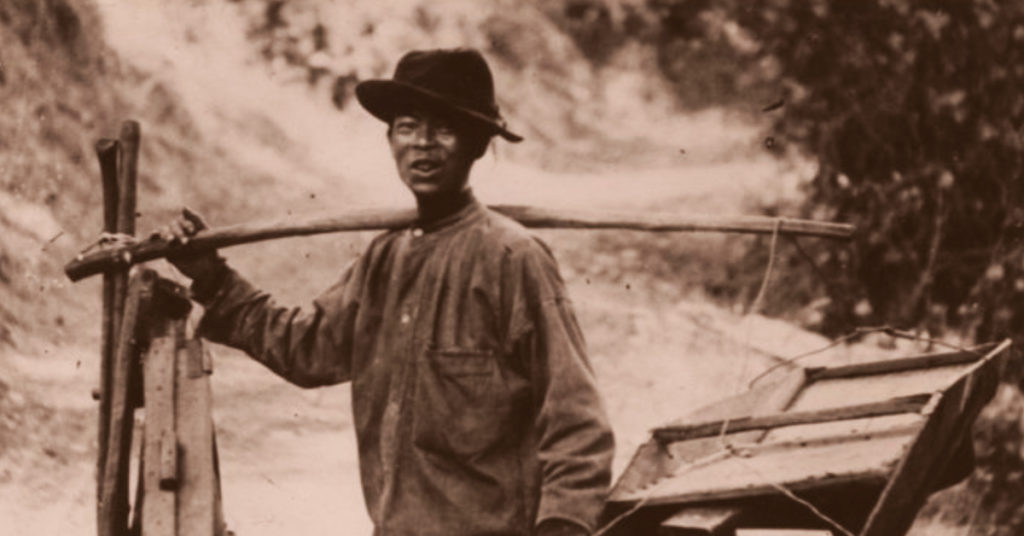
On January 24, 1848, gold was discovered in California at the site of Sutter’s Mill. It didn’t take long for the word to spread about this, and just a year later in 1849, the California Gold Rush had truly begun. Many Americans quickly found out about the news, and soon enough, this saw relocation to California skyrocket – with a reported 80,000 people making the move to the western state aiming to improve their wealth.
Eventually, people from all around the world were rushing to get their share of the gold. People as far away as China heard about the huge amount of gold within California, and wanted to dig for it themselves.
At the time, the poor living conditions in southeastern China meant that many Chinese men chose to escape their war-torn, famine stricken, and poor country with hopes of making a better life for themselves and their families. Their aim was to take full advantage of the gold rush so that one day, they could return to their homeland and share their new-found wealth with their loved ones.
In total, around 24,000 young Chinese men made the move from their homeland to California – living in camps which were set up for the miners so that they were close to their place of work and had a place to eat and sleep.

Not a Warm Welcome for the Chinese
However, despite moving to California with high hopes, the Chinese miners were greeted with huge animosity from many Americans. This was in spite of their incredible work ethic – working long hours in order to make a better living for themselves. As if things couldn’t get any worse, just three years down the line in 1852, the state of California placed a tax on all foreign miners – forcing all of the Chinese miners to either pay up or have to make their way back home.
But, this most definitely wasn’t the extent of their troubles while living in the mining camps. They also had to contend with violent attacks at the hands of other miners who targeted them. Matters were made worse due to the fact the US government favored its native citizens at this moment in time – often disregarding the Chinese in and other foreigners within the justice system.
In spite of this, the Chinese miners were determined to push past such negativity and continue paving the way to a more prosperous and wealthy future. So, they continued to work within the mines in order to achieve just that. Not everyone was happy to continue working in the gold mines though, with many making the decision to create their own businesses within the restaurant and laundry industries.
Eventually, the amount of wealth that could be earned from gold mining soon began to fall. This was due to the sheer amount of mining which had occurred, and the vast number of miners who were digging for gold. Essentially, the gold became harder to find, and the fierce competition for finding large quantities of gold became all too much for the miners. Ultimately, many of the Chinese miners made their way back to China with the gold they had obtained.

Many Chinese Stayed to Work
Not all of them left though. Many of the Chinese immigrants made the decision to settle permanently within western USA. The reason for this is that they were able to earn a better living for themselves as opposed to working similar jobs back home in China.
In the years that followed the California gold rush, other discoveries were made throughout the West. Many of the Chinese made their way to goldfields throughout Arizona, Nevada, Idaho, Oregon, Montana, and even Alaska.
The sheer number of Americans relocating to the west from eastern USA also meant that information and goods needed to be sent across the country. Soon enough, this led to the Pacific Railway Acts of 1862 and 1864 being passed by the Government.
Each of the acts meant that railroad companies were in need of a significant workforce, and to get the job done, they required a huge amount of railroad workers. A large number of the workers they employed happened to be immigrants. Controversially, the immigrants were paid less than the white railroad workers. However, the immigrants were still better off than in their homeland. So, they were happy to oblige and continued to work on the railroads for many years.
Moving to America – In Spite of Prejudice
Between the years of 1849 and 1882, the Chinese continued to relocate to America in order to improve their prospects – not only for themselves, but for future generations too. By 1876, the number of Chinese within the United States had increased to a total of around 151,000 – with 116,000 living within the state of California alone.
However, in 1882, the Chinese immigration was brought to an abrupt end. This was because President Chester A. Arthur signed the Chinese Exclusion Act on May 6, 1882.
Essentially, this brought an end to the Chinese moving to the USA, and it was the first time that a specific ethnic group had been prevented from immigrating to the United States. It was initially only intended to be a temporary measure for a total of 10 years, but it actually ended up being extended for many more years.
By 1943, the Magnuson Act was brought into place, meaning Chinese immigration was allowed once more.
Next: The Largest Chunk of Gold Ever Found on Earth
